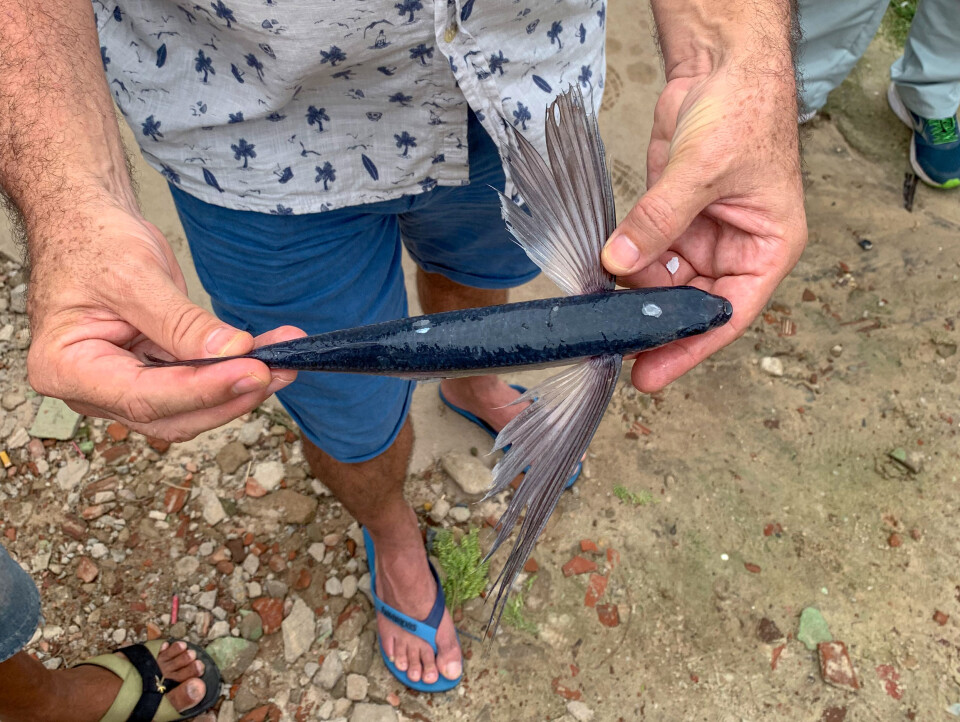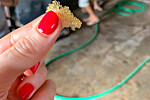
On the hunt for flying fish
“If you get sick and need to throw up, that’s fine, but if you don’t then that’s fine too,” says the skipper, laughing through his big smile, before setting off on the voyage taking nine excited business professionals and R&D representatives out on his boat towards the open sea. The location is Macau in northern Brazil. The goal: to harvest flying fish roe.
In recent years, flying fish roe has become an extremely important resource for local fishing communities such as Caiçara do Norte and Diego Lopes in Brazil. Fishing takes place near the continental shelf, which means about a three-hour trip by boat.
Roe blasters
Dried coconut branches are bundled together in a line using a rope and cast over the side of the boat. These bundles resemble the natural habitat in which the flying fish lay their eggs. Next, a mixture of flour and water is made and released into the water as bait. Olive oil is also dripped into the water to form a shimmer which attracts flying fish. Then the fish arrive, practically blasting out their roe as they swim around and around the branches.
Once the fish have finished spawning, the branches are pulled up and the roe is stripped off by hand, mixed with a little salt to inhibit the growth of bacteria, and stored on the boat.
The fishermen repeat this process, usually for three days at a time. Luckily, we’re only going to be joining for a few hours. There are nine passengers, along with a crew of three, aboard one of the largest boat in the area. Most of the other boats are around a third of the size of ours, and there are normally just three men on board – for three days, as previously mentioned. Here they fish, eat and sleep. Where they have space for the latter I still don’t understand, especially after seeing the small boats in person.
Low spirits on board

It’s 3 o’clock in the morning and we’ve been ferried aboard a boat with the help of a small raft. Trying to get over the high waves crashing along the shore in pitch-black darkness was a strenuous feat. The sea doesn’t look very inviting in the dark. The goal is to reach the continental shelf by dawn, because that’s the best time to find flying fish.
Wet and cold, we sit scattered about – some on a bench, some directly on the deck – aboard a boat that is most probably not designed for 12 people. We’re certainly all a little nervous about the voyage, but personally I am the most worried at the moment, because there are 12 of us on board – with no toilet facilities whatsoever – and the trip is estimated to take about 15 hours.
Yet I’m still in high spirits. I keep thinking that this an adventure, and that we’re lucky to be allowed to experience a fishing expedition with the local fishermen so we can really see and learn how flying fish are caught. Although, it’s really just the roe of this fish that we’re after.
After an hour’s sailing, with breakers so big there’s no hope of tracking the horizon, the mood on the boat begins to sour. The first of us to break is already hanging over the railings and throwing up. No one can bear to talk to each other any more. Everyone has enough on their plate just taking care of themselves and trying to find some fixed point to focus on. But there aren’t any. I stay stuck to the bench, breathing and focusing. I’m going get through this, I’m not going to be sick.
Creating added value
On this trip, we – a number of researchers from Norway and Brazil with different skills – came together to take a closer look at what we could do to help the first step in the value chain, the fishermen, get added value out of their catch. My colleague Torstein Skåra and I are on this mission in Brazil on behalf of the oil company Spectrum, which is doing seismological work in the area and wants to understand the fishermen’s situation. The fishermen toil to harvest the roe, but only get a fraction of the profits.

There’s a lot that can be done here, with relatively small measure, that would improve the quality and the process, and in turn increase profits. There’s also a lot that can be done to improve marketing efforts.
But nothing is quite so easy in these small communities in Brazil. This year, the fishermen were suddenly notified of new regulations imposed by authorities that prohibit them from using salt on their roe. No one knows why, but now they have to use ice instead. Small boats, with barely any room for crew and the roe, now need to have space to store ice too? With average temperatures around 30 degrees, and three days at sea at a time, this doesn’t make things any easier for these small fishing villages in Brazil. There is great poverty here, with little room for investment and lots of bureaucracy and corruption.
A popular garnish for sushi

Flying fish roe is a popular product on the global market. The roe is especially popular as a garnish for sushi. In Japan, it’s known as tobikoand is highly sought after. The roe is normally light yellow in colour and 0.5–0.8 millimetres in diameter, with a gentle smoky, salty flavour and an extremely crunchy texture. It also has a magical ability to take on the colour of other ingredients such as squid ink, beetroot, wasabi and yuzu (a citrus fruit), which turn the roe black, red, green and yellow respectively. This creates an amazing colour palette for the sushi.
Brazil is currently a minor supplier of this type of roe on the global market, mostly selling raw roe to Peru, where it is processed and sold to Asian countries – in particular Japan. In Peru, they separate the eggs from the roe sack and preserve it. Other countries such as Indonesia, Thailand, Taiwan, Russia and China are the major suppliers and exporters of this kind of roe.
In addition to competition from other countries, flying fish roe faces competition from roe from other fish, such as capelin, which is a cheaper product. And the price of flying fish roe varies drastically. You can pay anything from NOK 150 to well over NOK 1,000 per kilogram of flying fish roe online.
What happened, happened
I was doing all right until the boat stopped and anchored up to start fishing. If the breakers were big on the way out, they were nothing compared to the ones we faced now.
The crew began preparing food for us on board. The sight of raw chicken being filleted on the deck and the smell of deep frying was just too much. What happened, happened.
After five hours, with a “crew” flung about in every corner of the boat, the skipper realised it was best to return to shore. The only thing for it was to brace ourselves for the three-hour return voyage: plenty of time to dwell on the shameof our uselessness , and to think about the strenuous life these fishermen lead every single day. Safety and comfort is not the number-one priority here.
Our adventure out on the Brazilian fishing fields wasn’t quite as we’d hoped, but at least it gave us a good story to tell of our own misery.
The Brazil trip ended with a workshop in Natal, where researchers in biology, resource management, marketing, processing and economics from Norway and several parts of Brazil met and discussed the challenges and possible solutions to unlocking more profitability in these fisheries.
Work has already begun and it will be exciting to see how things pan out.







